Moondrop Kato Review - Is this Moondrop's best single-DD IEM?

Preface
The Kato is Moondrop’s latest single-DD IEM that is being touted by the company as an improved Moondrop KXXS. Incidentally, the KXXS is an IEM that’ll always have a special place in my collection because it’s the IEM that got me into the “IEM game” so to speak. I mean, there was the Drop Noble X that I purchased briefly before the KXXS, but I would prefer not to talk about that IEM - thanks.
Moving back to the Kato, I basically had one question in mind when I approached it, and that was whether it would be a true upgrade. This is because I do feel that Moondrop basically peaked with the KXXS in the single-DD game. Even the Illumination, for example, really had no technical chops and was out-resolved by Moondrop’s own SSR which came in at a fraction of the cost (no, seriously, basically 1/20th the cost). That aside, read on to find out whether I think Moondrop has redeemed themselves and their single-DD lineup through the Kato.
Moondrop Kato – Product Summary
- Reasons to buy
- Natural upgrade to the Moondrop KXXS and Aria
- Smooth tonal balance and technicalities
- Great build quality
- Reasons not to buy
- Treble extension hasn’t improved
- Sense of slam can still be lacking
 |
Get the Moondrop Kato for the best available price at headphones.com. |
This unit was provided for review by HiFiGo. As usual, what follows are my honest thoughts and opinions to the best of my ability.
Source & Drivability
All critical listening was done off of my iBasso DX300 and iPhone 13 Mini with lossless files, the stock cable, and stock silicone tips. The Kato requires a tad more juice to drive than some BA IEMs; however, I never found power to be an issue. Expectedly, there was no hissing from any of my sources.
In-the-Box

The Kato effortlessly demonstrates Moondrop's continued dedication to improving their packaging game. This waifu sports noticeably more defined lines and shadowing than its predecessor, more cute blush, and, of course, color. I'd say this is a solid 8/10 waifu in my book. Jokes aside, removing the sleeve reveals the following contents:
- Foam Ear tips s/m/l
- Silicon Ear tips s/m/l
- Gold & brass nozzles
- 0.78mm 2-pin cable
- Mesh baggy
- Carrying case w/ magnetic latch
- Waifu goodies

No, the weeb mat is not included. My package also included an extra cable, but I believe the production version will only include the cable shown below.
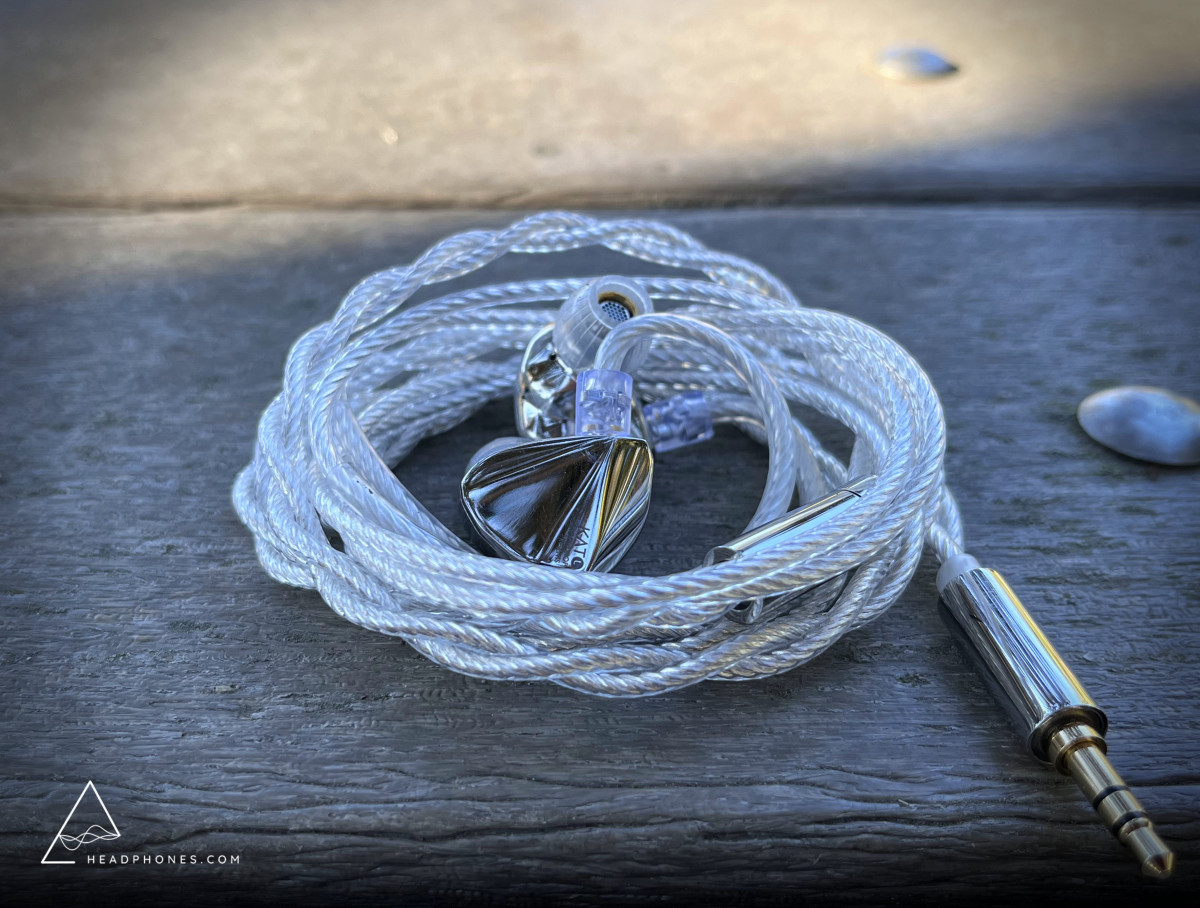
I've always been a fan of the KXXS's carrying case, and that hasn't changed with the Kato. It has a magnetic latch and a felt lining inside. The only real difference I observed is the addition of a silver stripe on the left of the flap.
The Kato itself follows the design that inspired its predecessor, but with some more angles at the back of the shell. I'm really not sure what the point of this is; it doesn't make a huge difference in terms of comfort, but I do feel that the original KXXS locks more securely into my ears. Perhaps this is partly due to the new silicone tips included with the Kato which are somewhat too springy for my preferences. That aside, build quality is good and the 0.78mm pins lock noticeably more securely than on my KXXS; they are recessed as well which is always a nice touch. The cable included with the Kato is also a solid step in the right direction. It is not as thin and tangly as the KXXS's, and generally feels more substantial in the hand.
Sound Analysis
The measurements below were taken using an IEC-711 coupler. There is a resonance peak at 8kHz and, as such, measurements after this point should not be considered entirely accurate. You can follow this link to compare the Moondrop Kato to other IEMs that I have graphed.
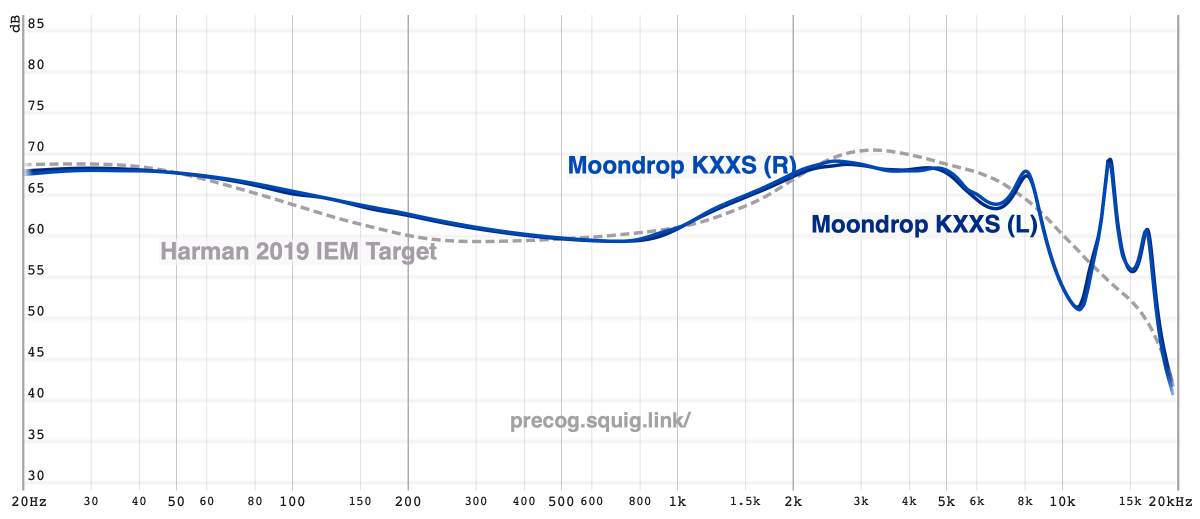
I’m not sure if I’ve ever done a tonal analysis of the KXXS, but it’s basically what I’d consider “warm-Harman”. The bass shelf of the KXXS delves into more mid-bass while eschewing some pinna gain relative to the Harman 2019 target, lending to a slightly smoother if not still upper-midrange oriented sound. This makes it a boon to listeners indexing for a more “weeb-y” sound. Conversely, the bass response of the KXXS would probably be its biggest weakness due to noticeable blunting and a general “pillowy-ness” to hits. Still, the KXXS is definitely an IEM that is propped upon its very good tuning, and the success of its budget follow-ups like the Aria and Starfield is proof of this.
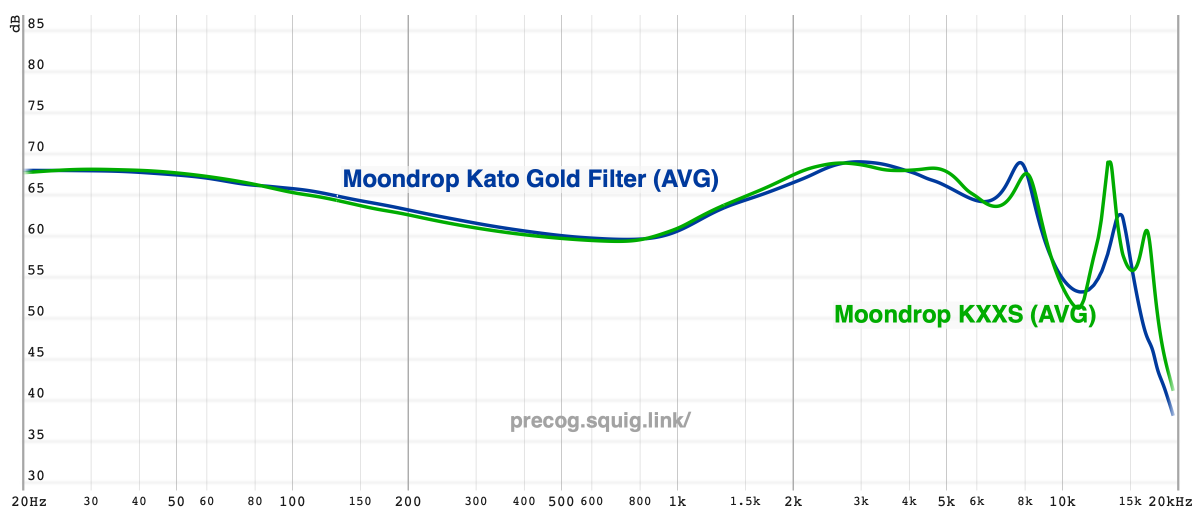
So what’s changed compared to the Kato? Well, the tonality differences between the KXXS and Kato are honestly small - small enough that one could probably chalk them up to margins of quality control, akin to tonal differences observed between the Starfield, KXXS, and Aria. That being said, I will outline the two distinctions that I observe with my particular units on the Kato (using either nozzle):
-
A slightly smoother upper-midrange response on the Kato.
-
A smoother treble response on the Kato, especially in the upper-treble.
The original KXXS had a slight bump to the presence regions from 3-4kHz which imparted a slightly thinner note weight and sense of clarity over its single DD brothers. The Kato is similarly lean, but eschews a wee bit of the shout that could turn off listeners on initial listen of the KXXS. Now, the second difference in the treble regions is more pronounced. The KXXS had a peak in the upper-treble at roughly ~12kHz which imparted a sense of tizzy-ness to treble instrument decay. Personally, I enjoyed that slightly hazy shimmer (I found it rather musical); however, some have found it peaky, an issue which the Kato likely rectifies. For sheer treble extension, I generally find the two IEMs to be at around the same level of performance; that is to say decent but nothing special. In essence, what you have here is a slight refinement over the KXXS’s sound signature.
Regarding the brass and silver nozzles that are included with the Kato, I’ve seen mixed impressions online. With the gold nozzle, I hear the Kato as having more treble air and sharpness up top. With the silver nozzle, the Kato is a little smoother in the transients and warmer overall. That might come as surprising given the color-scheme and the usual notions of audiophilia (copper = warmer, silver = brighter); nonetheless, it is what I hear and what the frequency response for my unit reflects.
Technical Performance
The KXXS was never a strong performer for technicalities with its generally smoothed over attack and congestion issues that stemmed from a double-whammy of excess mid-bass and the aforementioned shimmer in the treble. This is where I do find the Kato to be an improvement from its predecessor. Note attack is noticeably sharper on the Kato, and imaging performance has entered into respectable performance territory for $200. The Kato generally sounds like it has more control over nuances in more intensive tracks, slightly more transient speed in general. I’ll tell you what hasn’t been fixed, though: the dynamics on the Kato are not an improvement from its predecessor. It still sounds overly soft and flat to the way it punches. The opening baseline of SNSD’s “Whisper” sounds less like I’m being hit with a pillow on the KXXS than it does a half-hearted slap on the Kato due to the improved control in the low-end frequencies. Overall, I'd say you're looking at competitive technicalities for $200 - certainly more than its predecessor offered - I just wish the Kato had more "oomph" to it.
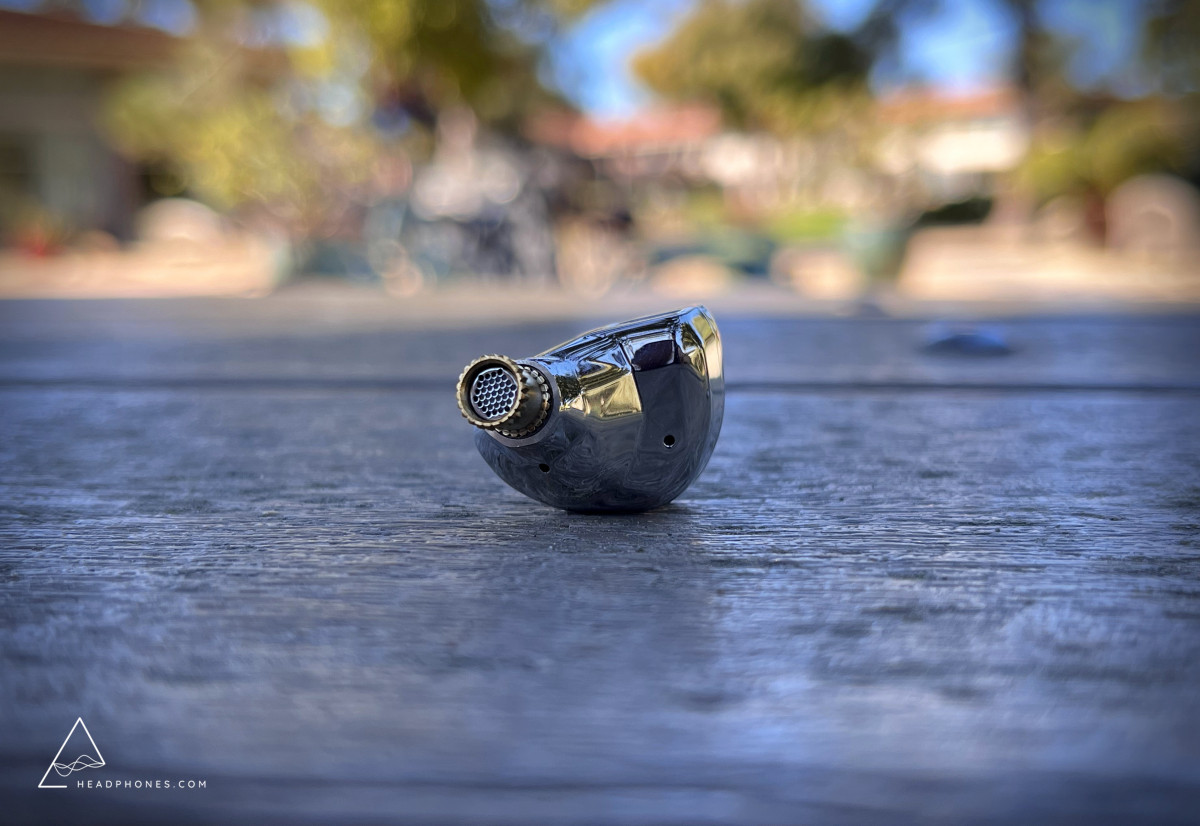
Select Comparisons
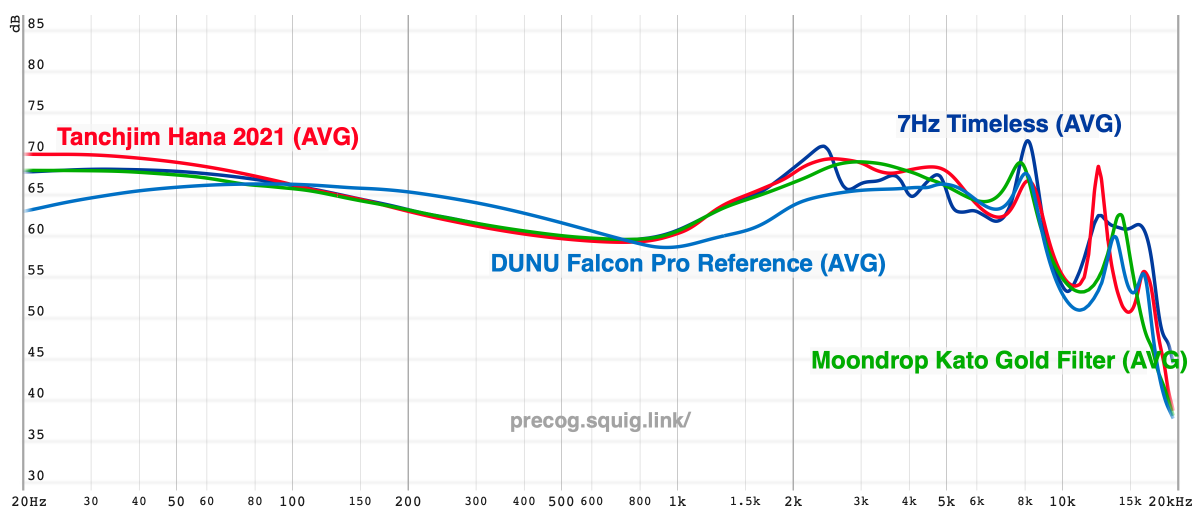
7Hz Timeless ($220): The latest hype train IEM. Head-to-head, I find the Kato to be tuned better and more likely to appeal to listeners who want a smoother sound: the bass on the Kato is more defined, the pinna gain is less peaky, and the treble response is smoother in the mid-treble. The Timeless is simply chock full of minor tuning errors that makes me think that more careful deliberation has gone into the Kato’s tuning. However, when it comes to technical performance, there can be no doubt that the Timeless pulls ahead with noticeably sharper transients and detail up-top; perhaps only falling short in the imaging department relative to the Kato. Go for the Kato for the more well-rounded package, go for the Timeless for the more technical package with more “wow” factor.
DUNU Falcon Pro ($220): The Falcon Pro generally has a warmer, more mid-bassy signature that’s going for a more “pleasant” sound overall. Consequently, I do find the Kato to have a noticeable edge in terms of sheer clarity, and I’d say that the Kato’s tuning is more up my alley when it comes to cleanliness of presentation. But I do find that - similar to the Tanchjim Hana 2021 - the driver used in the Falcon Pro is more pleasing intangibly. Timbre sounds noticeably more life-like on the Falcon Pro and it's a less flat sounding monitor when it comes to dynamic contrast. The treble response on the Falcon Pro also sounds more full and “sweet”. Honestly, I think these are both good IEMs, and I could probably swing for one or the other depending on my mood.
Tanchjim Hana 2021 ($180): You’ll notice that both the Timeless and Falcon Pro are slightly more expensive than the Kato. As a basis for what could be done better with the Kato on an even playing field, then, I find the Hana 2021 to be more technical than the Kato in A/B comparison. The driver being used in the Hana 2021 simply sounds more “hi-fi” to my ears; indeed, the Hana 2021 sports slightly more expansive imaging, natural decay, and impactful dynamics. Outside of this, they’re pretty similar tonally with the Hana 2021 sporting more energy in the sub-bass and lower-treble for a more exciting sound. I’d imagine most listeners would be splitting hairs over the technical differences, and preference of tonality could swing a listener one way or another between the two IEMs, but between the two, I’d lean for the Hana 2021.
The Bottom Line
I’d be remiss to mention that I tire of all these single-DDs from Moondrop, but given that 1) this is a legitimate improvement over the KXXS, and 2) it clocks in at the same price, it’s really difficult to complain. As it is, I find the Kato to be another solid addition to the Moondrop lineup, and while there are certainly some IEMs I’d prefer more at this price point (namely the Hana 2021), it’s hard to say that the Kato isn’t a really solid package for what you’re getting. The improved cable and waifu are just the cherry on top. Recommended.
-Precogvision
